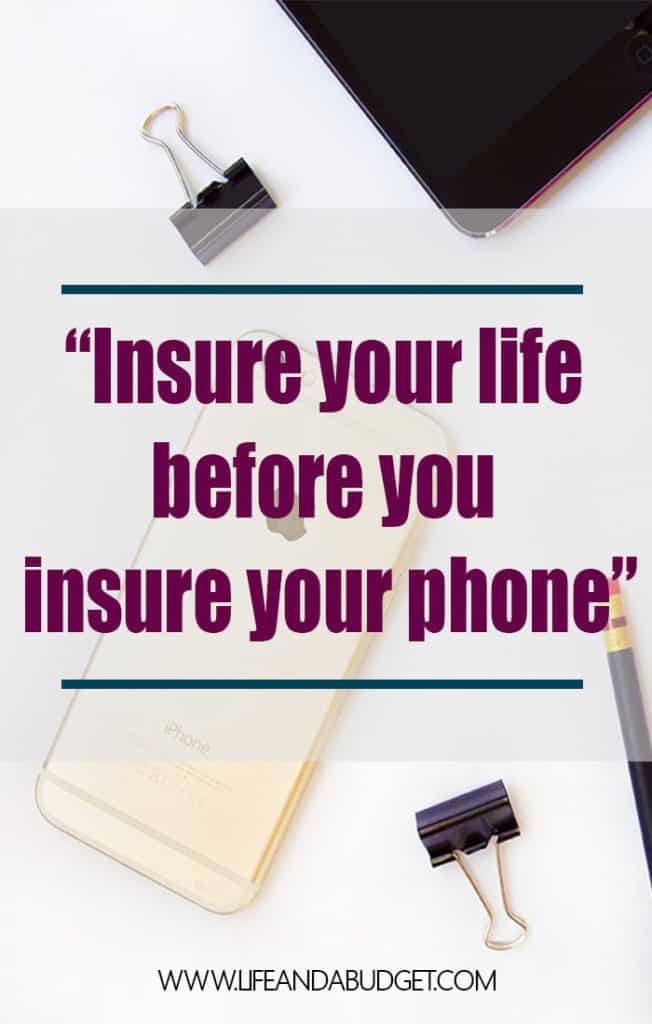Life insurance is not a topic most people want to talk about. The thought of you or a loved one no longer being around doesn’t make for good dinner conversation. However, it’s a reality we all must come to terms with. According to LIMRA’s (Life Insurance and Market Research Association) latest study, only 60 percent of Americans report having life insurance.
This is a big problem because, without life insurance, many families are left to shoulder financial burdens. Without money to bury loved ones, many are now depending on GoFund Me pages. Fortunately, all of this can be solved with a little planning. This is what I want to help you out with today.
But first, imagine this really quick…
Janene and Max are in their late 30s. Both have great jobs in the engineering and nursing. They pride themselves on their education and the fact they have a decent amount of money set aside for future emergencies. They don’t spend more than necessary; however, they love keeping up with new technology.
Every new iPhone that hits the market is in their hand before the end of the release date. They love their iPads and MacBooks too and so do their teenage twin daughters, Chelsea and Camilla. Not thinking twice about it, they always make sure all of their devices are insured too.
They have the typical types of insurance most American’s have — auto, homeowners, and health insurance. Their life insurance situation leaves much to be desired, though.
Janene has a $25,000 life insurance policy through her job and Max has a $50,000 life insurance policy through his place of employment. They don’t have any insurance on their kids, following that age old advice that young kids don’t need life insurance.
Max figures since they have insurance through their jobs, they at least have enough to provide each other with a decent funeral. Also, the girls have 529 accounts to depend on if anything were to happen to him or Janene before they go to college.
One weekend the girls had a cheerleading competition in Charleston, about 200 miles from their home in Rutherfordton, NC. Janene rode to the event with the girls using school transportation. Max traveled separately because of work obligations.
It was rainy that weekend and the school bus was at max capacity with coaches, cheerleaders, and parent chaperones.
About 30 miles south of Columbia, the rain really started to really pour down. The nearest rest stop was about 45 minutes away. The head cheer coach encouraged the bus driver to pull over on the side of the road until the rain eased up.
The driver and the coach thought they would be safer on the side of the road until visibility improved, but they never anticipated that an 18 wheeler would come speeding down the highway. The truck driver was driving too fast for conditions and lost control of the truck after one of its tires blew out.
While they sat on the side of the highway waiting for more favorable driving conditions – they sat in harm’s way as the truck came barrelling towards them.
I’m going to end that little story there and allow you to come to your own conclusions.
You can be optimistic and conclude that Janene and her two daughters walked away with only a few scratches. Or you can believe the alternative. The alternative would, unfortunately, conclude that Max is not only going to be emotionally distraught, but he’s going to have a difficult time recovering financially as he prepares to bury his entire family with an insufficient amount of insurance.
Regardless of what you decide to believe, the point in sharing this is to hopefully drive home the fact that we can’t control what life throws at us. All we can do is prepare as best as we can. One way to prepare for anything is through saving money and having the right kind and right amount of insurance.
Do you have enough insurance? Calculate how much you need and purchase life insurance here today.

Life Insurance – What You Need to Know
After working in the insurance industry for the last 10 years, I recommend young families purchase term-life insurance. Why? Well, because it’s affordable and it provides sufficient coverage to meet the financial needs of families if a primary breadwinner passes away.
You might not think you have enough money in your budget to purchase life insurance, but I’m here to tell you that you can’t afford NOT to have life insurance. Despite how tight you may think your budget is, just imagine how tight things would be if you were to lose a source of income you’ve grown to depend on?
Bills will continue to come. Debt balances will continue to grow. And unfortunately, life will go on. Will you have the means to continue paying your bills? Will you lose your home without that one income? If something were to happen to both spouses, would your children be taken care of financially?
Related Reading: 10 Sneaky Unexpected Expenses You’re Forgetting to Budget For, How to Create a Budget That Won’t Fail
Who should purchase life insurance?
Everyone should have some type of life insurance. Yes, even children. I hear arguments all the time about not purchasing life insurance for children because they are young. Unfortunately, we live in a world where parents are burying their children all the time.
Likewise, all adults should have enough life insurance to cover burial expenses, debt, and living expenses for family members. Everyone’s situation will be different so there are many things you should consider such as the amount of dependents you have, debt, etc — which we’ll discuss next.
How Much Life Insurance Do You Need
According to the National Funeral Directors Association, funerals for adults in 2014 sat at a hefty sum of $8,508. Not only do you need enough insurance to cover funeral costs, but you will also need it to take care of your family and remaining financial obligations.
If your loved one was sick or injured before death and required medical care — you will need money to pay for their medical bills. If you and your spouse have a fair share of student loans, mortgages, and other consumer debt — you will need money to pay off that debt.
Do you have kids in college? If you’ve co-signed on a Parent Plus loan, you’re still responsible for paying that debt even if your child passes away. Many assume that having a small policy on their children will suffice, but having enough to bury them isn’t always the case if debt is involved.
Most experts recommend purchasing 10 to 12 times the amount of all combined income in life insurance.
Using Janene and Max as an example, Janene’s salary was $65,000 and Max’s salary was $110,000. This means Janene should have anywhere from $650,000 to $780,000 in life insurance. Max should have $1,100,000 to $1,320,000. The idea is to have enough to cover that spouses portion of the debt and to replace their lost income for years to come.
Everyone is worth something
Also, you should consider the spouses who live with you that don’t work as well. If your spouse takes care of daily chores such as cleaning, cooking, taking the kids to school, etc — consider the financial impact of losing those contributions. If this spouse were no longer there to contribute to the household in this way, how much would it cost to have someone provide these services?
The amount of insurance you should purchase may shock you and leave you feeling like life insurance isn’t affordable. However, it’s more affordable than you think, which we’ll discuss more in a minute. First, you should understand the difference between the two more popular types of policies — term-insurance and whole insurance.
Calculate how much insurance you need and purchase life insurance today using this free tool.
The differences between Term-Life Insurance and Whole Insurance
Term-life insurance is the most affordable of the two because you’re only receiving coverage for the term specified in the policy. Policy terms typically range from 10 to 30 years .
Likewise, whole (permanent) insurance is more expensive because benefits are paid out after death and these policies usually have a cash-value accumulation feature. Whole insurance premiums do not increase as the insured ages and the policy remains in effect for the entire life of the insured, so long as premiums are paid.
Policy payouts for whole life insurance range from anywhere to $1,000 and up, whereas term-life insurance policy payouts are substantially higher.
How much does life insurance cost?
Term-life insurance is considerably cheaper than whole life insurance because it’s only available for a given term set forth in the policy and does not accumulate cash value. These policies are ideal for young couples because they are more affordable and they are enough to cover financial obligations if a loved one passes away during the specified term.
With that said, you should seek term-life insurance as early as possible to lock in decent premium rates. Younger couples often secure the best rates; however, middle-aged couples might have a harder time finding a low competitive rate, but that doesn’t mean they shouldn’t try.
Your needs change as you age too. A younger couple might need a larger payout that a term policy provides if they have debt. Older couples may need less insurance as their debt and financial obligations decrease.
If Janene and Max had purchased term-life insurance in their 20s, they could have secured rates between $16 to $28 for Janene (based on a general sample quote, optimal health) and $28.00 to $40 for Max. Since they are in their late 30’s their rates would probably be higher than this. However, they could opt for a shorter-term policy (10 to 20 years) since their kids are close to leaving for college and they have a decent amount of college savings for them.
Whole life insurance is determined by many factors such as the age of the insured, cash accumulation, and policy payout — therefore, it would be more difficult to determine an accurate rate without a professional quote. These policies would be ideal if both children were no longer dependent on them financially and they just needed enough insurance for a proper burial.
What if you have insurance with your job?
Many employers provide employees with life insurance; however, it’s usually not anywhere near the suggested amounts of 10 to 12 times your income.
If you were to lose your job, it is unlikely that you will be able to secure the same rate if the policy were converted to an individual policy.
For instance, I work for an insurance company that offers really great rates for employees. The job pays an additional $50,000 in life insurance for me; however, I pay out of pocket for insurance on my husband and my children (although it’s still a considerably lower rate than the insurance my husband and I have outside of my company).
You may be wondering if I’m over insured, and I can assure you I’m not. I purchased the additional coverage because I’m literally paying pennies on the dollar per pay period for ALL additional coverages on my family.
Of course, if I left my job the rates wouldn’t be the same. However, I’m paying pennies for whole life insurance for my kids. I couldn’t secure this rate outside of work even if I tried! In the event I ever left my job, my mother-in-law purchased small Gerber life policies on both kids so I know they would still have some coverage.

Conclusion
So basically, this is what you need to remember:
- You and your spouse should have 10 to 12 times the amount of your income in life insurance.
- If you’re young, life insurance is cheap and can protect your family in the event something happens to you.
- Whole insurance policies are more expensive; however, they are ideal for individuals who don’t have debt or many financial obligations. A small whole insurance policy ($10,000 to $15,000) is also ideal for children.
- Regardless your situation, there is a life insurance policy out there that will fit in your budget. Based on your individual family’s needs, you may need whole, term, or a mix of both.
- If you can insure your iPhone, you can insure your life (don’t even get me started on that)!
Regardless of your financial situation, there is a life insurance policy that will suit your needs and your budget. If you do not have life insurance, I recommend using Policy Genius to compare life insurance policies TODAY. This tool is FREE and easy to use.
Get competitive rates and purchase life insurance today using Policy Genius because tomorrow isn’t promised and you don’t want to leave your family unprotected!
Do you have life insurance? If not, what’s stopping you?

